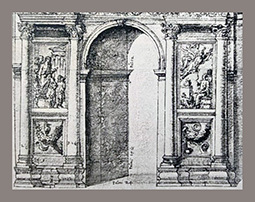Autore: W. Raganelli
Scarica l’articolo in formato .pdf: L’Arco di Portogallo sulla Via Lata. Una lettura attraverso le testimonianze antiche e moderne
 Questo contributo prende in esame il cosiddetto Arco di Portogallo lungo l’antica via Lata, un monumento che è stato soggetto a varie attribuzioni fin dal Rinascimento. Negli ultimi decenni diversi studi hanno proposto una datazione compresa tra il secondo e il quarto secolo d.C. Partendo da un passaggio del Panegirico per il sesto consolato di Onorio scritto da Claudiano, il lavoro tenta di gettare luce sulla storia dell’arco attraverso l’analisi della sua architettura, conosciuta soprattutto grazie ai disegni rinascimentali, e degli elementi iconografici attribuibili ad esso, per procedere poi a un confronto con altri monumenti per i quali è possibile accertare casi di rifunzionalizzazione e reimpiego. I dati acquisiti offrono l’opportunità di rivalutare la cronologia del monumento anche a fronte delle testimonianze contenute nelle fonti letterarie di quindicesimo secolo.
Questo contributo prende in esame il cosiddetto Arco di Portogallo lungo l’antica via Lata, un monumento che è stato soggetto a varie attribuzioni fin dal Rinascimento. Negli ultimi decenni diversi studi hanno proposto una datazione compresa tra il secondo e il quarto secolo d.C. Partendo da un passaggio del Panegirico per il sesto consolato di Onorio scritto da Claudiano, il lavoro tenta di gettare luce sulla storia dell’arco attraverso l’analisi della sua architettura, conosciuta soprattutto grazie ai disegni rinascimentali, e degli elementi iconografici attribuibili ad esso, per procedere poi a un confronto con altri monumenti per i quali è possibile accertare casi di rifunzionalizzazione e reimpiego. I dati acquisiti offrono l’opportunità di rivalutare la cronologia del monumento anche a fronte delle testimonianze contenute nelle fonti letterarie di quindicesimo secolo.
This contribution examines the so-called Arch of Portugal along the ancient Via Lata, a monument that has been the subject of numerous attributions since the Renaissance. In the recent decades some studies have proposed a dating between the second and the fourth centuries. Starting from a passage of the Panegyric for the 6th consulate of Honorius written by Claudian, the work attempts to shed light on the history of the arch through the analysis of its architecture, known mainly thanks to Renaissance drawings, and the iconographic elements attributable to it, to which follows a comparison with other monuments for which it is possible to ascertain cases of re-functionalization and re-use. The acquired data offer the opportunity to re-evaluate the chronology of the monument even against the evidence contained in the literary sources of the fifteenth century.
